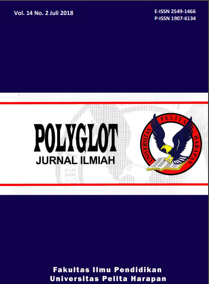PENERAPAN METODE GIVING QUESTIONS AND GETTING ANSWERS UNTUK MENINGKATKAN KETERAMPILAN BERPIKIR KRITIS SISWA KELAS X-MIA DI SEKOLAH ”˜FANÓS’ KUPANG [IMPLEMENTATION OF THE GIVING QUESTIONS AND GETTING ANSWERS METHOD TO IMPROVE CRITICAL THINKING SKILLS WITH GRADE 10-MIA STUDENTS AT 'FANÓS' KUPANG]
DOI:
https://doi.org/10.19166/pji.v14i2.846Trefwoorden:
Giving Questions and Getting Answers, critical thinking skills, Classroom Action Research, Memberikan Pertanyaan dan Mendapatkan Jawaban, keterampilan berpikir kritis, penelitian tindakan kelasSamenvatting
Critical thinking is one of the higher order thinking skills that high school students must have. Grade 10-MIA students in ”˜FANÓS’ School Kupang had difficulties improving their critical thinking skills. The researcher used the Giving Questions and Getting Answers method to help these students improve their critical thinking skills. The purpose of this research was to find out whether there was any improvement in students’ critical thinking skills when the Giving Questions and Getting Answerss method was implemented in their school. This research method used Classroom Action Research (CAR) by Kemmis and McTaggart’s model in two cycles. The subjects consisted of 30 Grade 10-MIA students. The research instruments were check-list observation sheet, students’ questionnaire, mentor’s interview sheet, post-test sheet with its rubric, mentor’s observation sheet and open observation sheet. The result was analyzed using descriptive statistics and qualitative. The results showed that Giving Questions and Getting Answers could improve Grade 10-MIA students’ critical thinking skills when explaining the functions of the two papers, explaining the lesson, group discussion, asking questions from the 1st paper, giving conclusions from the 2nd paper and giving a post-test.
BAHASA INDONESIA ABSTRAK: Berpikir kritis adalah salah satu keterampilan berpikir tingkat tinggi yang dimiliki siswa SMA. Siswa kelas X-MIA di Sekolah 'FANÓS' Kupang mengalami kesulitan dalam memperbaiki kemampuan berpikir kritis mereka. Peneliti menggunakan metode Pemberian Pertanyaan dan Mendapatkan Jawaban untuk membantu siswa kelas X-MIA untuk meningkatkan kemampuan berpikir kritis mereka. Tujuan dari penelitian ini adalah untuk mengetahui apakah ada perbaikan kemampuan berpikir kritis siswa atau tidak dan untuk mengetahui bagaimana cara memberikan pertanyaan dan mendapatkan jawaban diimplementasikan di Sekolah FANÓS Kupang. Metode penelitian yang digunakan adalah Penelitian Tindakan Kelas (PTK) dengan model Kemmis dan McTaggart. Subjek penelitian adalah siswa kelas X-MIA yang terdiri dari 30 siswa. Penelitian tindakan kelas ini dilakukan dalam dua siklus. Instrumen penelitiannya adalah lembar observasi daftar periksa, kuesioner siswa, lembar wawancara mentor, lembar post-test dengan rubriknya, lembar observasi mentor dan lembar observasi terbuka. Hasilnya dianalisis dengan statistik deskriptif dan kualitatif. Hasil penelitian ini adalah Memberikan Pertanyaan dan Mendapatkan Jawaban dapat meningkatkan kemampuan berpikir kritis siswa kelas X-MIA dan diimplementasikan dengan menjelaskan fungsi kedua makalah tersebut, menjelaskan pelajaran, diskusi kelompok, mengajukan pertanyaan dari makalah pertama, pemberian kesimpulan dari kertas ke-2 dan memberikan post-test.
Referenties
Arikunto, S. (2009). Dasar-dasar evaluasi pendidikan. Jakarta, Indonesia: PT. Bumi Aksara.
Chasanah, A., Santosa, S., & Ariyanto, J. (2012). Pengaruh penerapan model pembelajaran giving questions and getting answers terhadap hasil belajar siswa kelas X SMAN Banyudono tahun ajaran 2011/2012. Jurnal Pendidikan Biologi, 4(3), 29-38. Retrieved from http://jurnal.fkip.uns.ac.id/index.php/bio/article/view/1424
Hendricks, H. G. (2013). Mengajar untuk mengubah hidup. Yogyakarta, Indonesia: Yayasan Gloria.
Hergenhahn, B. R. & Olson, M. H. (2009). Theories of learning edisi ketujuh. Jakarta, Indonesia: Kencana.
Idol, L. & Jones, B. F. (2010). Educational values and cognitive instruction: Implications for reform. New York, NY: Lawrence Erlbaum Associates.
Knight, G. R. (2009). Filsafat dan pendidikan: Sebuah pendahuluan dari perspektif Kristen. Jakarta, Indonesia: Universitas Pelita Harapan Press.
Paul, R. & Elder, L. (2005). A guide for educators to critical thinking competency standards. Dillon Beach, CA: The Foundation of Critical Thinking. Retrieved from http://www.criticalthinking.org/resources/PDF/CT-competencies%202005.pdf
Santrock, J. W. 2009. Educational psychology. New York, NY: McGraw-Hill
Silberman, M. L. (2014). Active learning: 101 cara belajar siswa akif. Bandung, Indonesia: Nuasa Cendekia.
Suryanti. (2013). Pembelajaran giving questions and getting answers untuk meningkatkan kemampuan berpikir kritis pada mata kuliah aljabar linier bagi mahasiswa. Jurnal Cakrawala Pendidikan, 15(2), 230-235. Retrieved from http://digilib.stkippgri-blitar.ac.id/274/
Wiriaatmadja, R. (2009). Metode penelitian tindakan kelas untuk meningkatkan kinerja guru dan dosen. Bandung, Indonesia: PT Remaja Rosdakarya.
##submission.downloads##
Gepubliceerd
Nummer
Sectie
Licentie
Authors who publish with this journal agree to the following terms:
1) Authors retain copyright and grant the journal right of first publication with the work simultaneously licensed under a Creative Commons Attribution License (CC-BY-SA 4.0) that allows others to share the work with an acknowledgement of the work's authorship and initial publication in this journal.
2) Authors are able to enter into separate, additional contractual arrangements for the non-exclusive distribution of the journal's published version of the work (e.g., post it to an institutional repository or publish it in a book), with an acknowledgement of its initial publication in this journal.
3) Authors are permitted and encouraged to post their work online (e.g., in institutional repositories or on their website). The final published PDF should be used and bibliographic details that credit the publication in this journal should be included.





